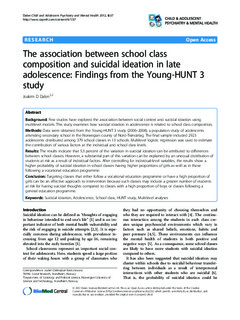| dc.contributor.author | Dalen, Joakim Døving | |
| dc.date.accessioned | 2015-09-29T11:09:54Z | |
| dc.date.accessioned | 2015-10-07T14:42:53Z | |
| dc.date.available | 2015-09-29T11:09:54Z | |
| dc.date.available | 2015-10-07T14:42:53Z | |
| dc.date.issued | 2012 | |
| dc.identifier.citation | Child and Adolescent Psychiatry and Mental Health 2012, 6 | nb_NO |
| dc.identifier.issn | 1753-2000 | |
| dc.identifier.uri | http://hdl.handle.net/11250/2353228 | |
| dc.description.abstract | Background: Few studies have explored the association between social context and suicidal ideation using
multilevel models. This study examines how suicidal ideation in adolescence is related to school class composition.
Methods: Data were obtained from the Young-HUNT 3 study (2006–2008), a population study of adolescents
attending secondary school in the Norwegian county of Nord-Trøndelag. The final sample included 2923
adolescents distributed among 379 school classes in 13 schools. Multilevel logistic regression was used to estimate
the contribution of various factors at the individual and school class levels.
Results: The results indicate that 5.3 percent of the variation in suicidal ideation can be attributed to differences
between school classes. However, a substantial part of this variation can be explained by an unequal distribution of
students at risk as a result of individual factors. After controlling for individual-level variables, the results show a
higher probability of suicidal ideation in school classes having higher proportions of girls as well as in those
following a vocational education programme.
Conclusion: Targeting classes that either follow a vocational education programme or have a high proportion of
girls can be an effective approach to intervention because such classes may include a greater number of students
at risk for having suicidal thoughts compared to classes with a high proportion of boys or classes following a
general education programme. | nb_NO |
| dc.language.iso | eng | nb_NO |
| dc.publisher | BioMed Central | nb_NO |
| dc.title | The association between school class composition and suicidal ideation in late adolescence: Findings from the Young-HUNT 3 study | nb_NO |
| dc.type | Journal article | nb_NO |
| dc.type | Peer reviewed | en_GB |
| dc.date.updated | 2015-09-29T11:09:54Z | |
| dc.source.volume | 6 | nb_NO |
| dc.source.journal | Child and Adolescent Psychiatry and Mental Health | nb_NO |
| dc.identifier.doi | 10.1186/1753-2000-6-37 | |
| dc.identifier.cristin | 966859 | |
| dc.description.localcode | © 2012 Dalen; licensee BioMed Central Ltd. This is an Open Access article distributed under the terms of the Creative Commons Attribution License ( http://creativecommons.org/licenses/by/2.0), which permits unrestricted use, distribution, and reproduction in any medium, provided the original work is properly cited. | nb_NO |
